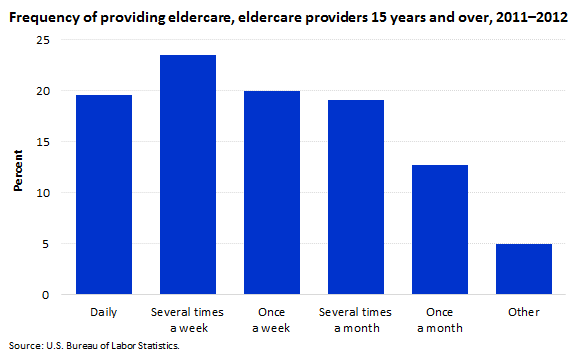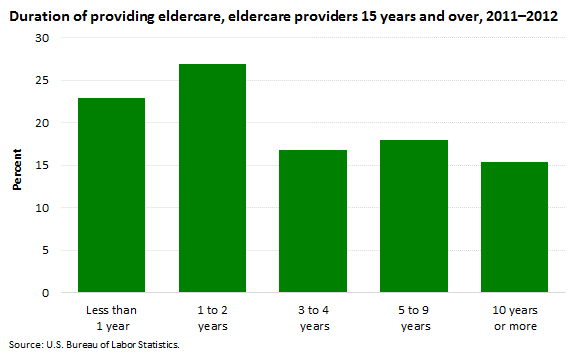An official website of the United States government
 United States Department of Labor
United States Department of Labor
During the 2-year 2011–2012 period, 39.6 million people age 15 and over (16 percent of the U.S. civilian noninstitutional population) provided unpaid eldercare.

| Frequency | Percent |
|---|---|
Total, 15 years and over | 100.0 |
Provided care daily | 19.6 |
Provided care several times a week | 23.5 |
Provided care once a week | 20.0 |
Provided care several times a month | 19.1 |
Provided care once a month | 12.7 |
Other | 5.0 |
Note: Survey participants were asked how often they provided care in the past 3 to 4 months; this information was used to categorize them by frequency of care. | |
During this period, 43.1 percent of eldercare providers furnished care daily or several times a week (19.6 percent and 23.5 percent, respectively), while 12.7 percent provided care once a month.

| Duration | Percent |
|---|---|
Total, 15 years and over | 100.0 |
Provided care for less than 1 year | 22.9 |
Provided care for 1 to 2 years | 26.9 |
Provided care for 3 to 4 years | 16.8 |
Provided care for 5 to 9 years | 18.0 |
Provided care for 10 years or more | 15.4 |
Note: For persons who provided eldercare to more than 1 person, the duration of care is calculated based on the person for whom they had cared the longest. | |
Over the same period, 49.8 percent of eldercare providers had provided care for 2 years or less (22.9 percent had provided care for less than 1 year and 26.9 percent had provided care for 1 to 2 years), while 15.4 percent had provided care for 10 years or more.
These data are from the American Time Use Survey. To learn more, see "Unpaid Eldercare in the United States — 2011-2012 Data from the American Time Use Survey" (HTML) (PDF), news release USDL-13-1886. Eldercare providers are defined as individuals age 15 and over who provide unpaid care to someone age 65 or older who needs help because of a condition related to aging. This care can be provided to household or nonhousehold members, as well as persons living in retirement homes or assisted care facilities. These estimates are averages for the 2-year period of 2011 and 2012; combining the 2 years of data facilitates a more in-depth analysis of eldercare.
Bureau of Labor Statistics, U.S. Department of Labor, The Economics Daily, Frequency and duration of eldercare, 2011–2012 at https://www.bls.gov/opub/ted/2013/ted_20131021.htm (visited January 10, 2026).

